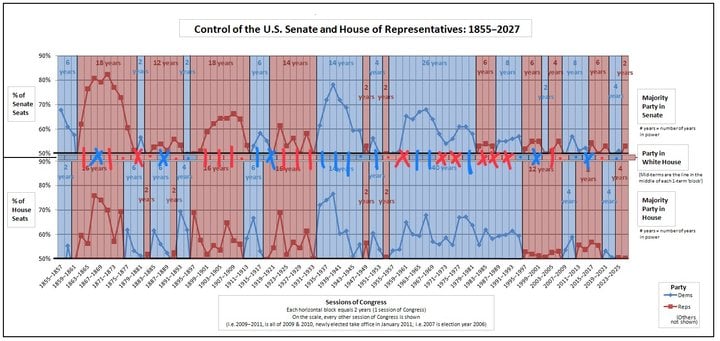Midterms to the rescue? Maybe. Maybe not.
Since the end of the Cold War, voters tended to constrain a sitting President‘s power by supporting the opposition in the midterm elections which regularly produced lame duck presidencies after their first two years in office. It happened to Bill Clinton, Barack Obama, Donald Trump and to Joe Biden. George W. Bush, however, won Congressional majorities in 2002. Still, he lost them - as the theory would suggest - in 2006, two years into his second term. And one shouldn’t discount the post-9/11 effect.
Having said that, historically, the post-1992 norm is more of an aberration than a constant. During the civil war and reconstruction era Lincoln (during his first and likely his second term) and Grant (during his first term) were able to rely on solid Republican majorities in Congress. Though, that was in part due to the self-disenfranchisement of the Southern Democrats.
Still, around the turn of the century, both McKinley and Theodore Roosevelt were backed by a Republican Congress for the whole duration of their three terms.
Wilson wasn’t immediately rebuffed by the electorate either in 1914. Voters gave him two more years to enact his ambitious, progressive reform agenda.
During the roaring twenties Harding, Coolidge and Hoover were backed by solid and uninterrupted majorities on the Hill for 12 years.
History, then, repeated itself when Franklin D. Roosevelt presided over the US, undisturbed by Republican majorities in either chamber for over 12 years.
Finally, Kennedy, Johnson and Carter didn’t have to contend with a decisive midterm reaction either.
Having said that, historically, the post-1992 norm is more of an aberration than a constant. During the civil war and reconstruction era Lincoln (during his first and likely his second term) and Grant (during his first term) were able to rely on solid Republican majorities in Congress. Though, that was in part due to the self-disenfranchisement of the Southern Democrats.
Still, around the turn of the century, both McKinley and Theodore Roosevelt were backed by a Republican Congress for the whole duration of their three terms.
Wilson wasn’t immediately rebuffed by the electorate either in 1914. Voters gave him two more years to enact his ambitious, progressive reform agenda.
During the roaring twenties Harding, Coolidge and Hoover were backed by solid and uninterrupted majorities on the Hill for 12 years.
History, then, repeated itself when Franklin D. Roosevelt presided over the US, undisturbed by Republican majorities in either chamber for over 12 years.
Finally, Kennedy, Johnson and Carter didn’t have to contend with a decisive midterm reaction either.



